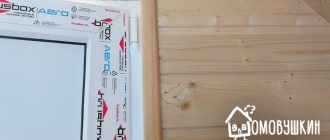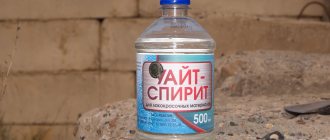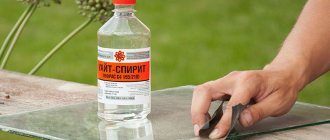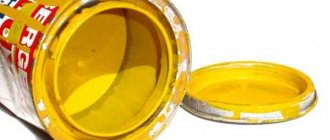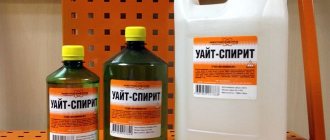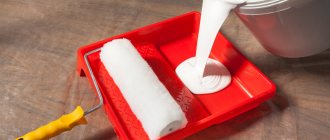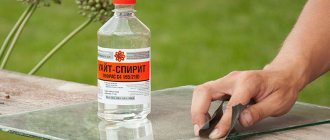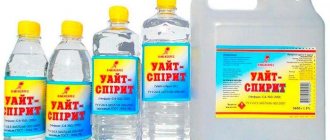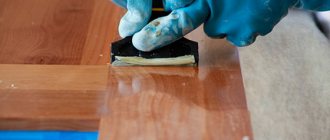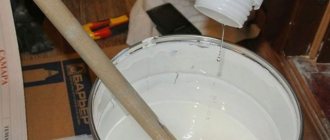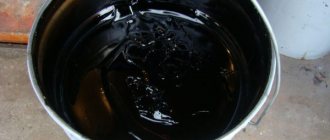Features of solvent 646. GOST
Today, manufacturers produce 2 types of 646 brand solvent. The first type is technically produced, which allows you to replace the elements with the most inexpensive and least high-quality analogues.
The second type is produced according to Soviet standards, which were studied back in 1972. Since the founding stage of its production according to the conditions, sales have increased significantly.
- This stage is due to the fact that having determined the general composition of this product from chemical companies, it was possible to add unique properties to the multicomponent compound that the solvent did not previously possess. The element was widely used in the manufacture of paint and varnish products, which did not live up to current stereotypes.
- But despite the emergence today of the newest varnishes and paints that are safe for people and the environment, which do not contain heavy compounds, the standard solvent is one of the favorites of these products.
As before, certain types of paints and varnishes are produced on its basis, but it is also used as a thinner for various watery building materials.
R-4
Solvent R-4 differs from 646 in the large amount of acetone in the composition and less toluene. The addition of P-4 reduces the ability of the coating to fade and increases the gloss level.
The product is used as a thinner for putty and paintwork materials marked MS, PVC, HV, HS, HSL, EP. A relatively non-aggressive solvent is also used for washing construction tools and hands after working with the listed materials. In this case, it is necessary to seek medical help.
You need to wash your hands after working with paintwork materials Source kd-nn.ru
Safety measures regarding working with solvent R-4 are identical to 646 and 647. With prolonged inhalation of vapors, not only dizziness and coughing are possible, but also poisoning of the body.
Molecular structure of solvent 646
Thinner 646 GOST 18188-72 has a certain texture of chemical elements:
- Toluene - 50%;
- Ethyl alcohol - 15%;
- Butanol - 10%;
- Butyl acetate - 10%;
- Ethylcellosol - 8%;
- Acetone - 7%.
It should be noted that methylbenzene and acetone are considered precursors, drugs included in the production of narcotic substances.
For this reason, many manufacturers produce a chemical that allows the final concentration of acetone and toluene to be reduced to less than 50% in consistency.
How to store it correctly?
The solvent is stored in a tightly closed container. In addition, the container with the reagent must be protected from moisture, direct sunlight, and heat. Do not leave any heating devices in close proximity to solvent containers.
The guaranteed shelf life (according to manufacturers' information) from the date of manufacture is 12 months, which allows enterprises to purchase these products in large quantities.
The temperature values at which the solvent is stored are in the range from minus 40 to plus 40 degrees.
Solvent properties 646
This consistency is considered a clear liquid, can have a yellowish tone, and has a standard light aroma.
The conditional saturation of the substance is 0.87 g/cm3 and allows it to be completely mixed with other organic combinations.
Has distinctive features:
- Dilution process. The method is used to dilute thick enamels, as well as paints, putties, film-forming varnishes, in order to achieve the required structure. Forms an even, smooth coating on the painted surface.
- Ability to dissolve. Effectively dilutes the thickness and also dissolves dirt and paint stains from various surfaces.
- Poisonous qualities. When exposed to high levels of vapors in the atmosphere, people are likely to experience loss of orientation, frequent dizziness and other negative effects. Great stress for the eyes, the respiratory system, stomach and intestines, and liver work worse. Prolonged contact aggravates the condition of the blood structure, dulls consciousness, leading to disastrous consequences.
- Hostile to certain types of plastic.
- Refers to flammable solutions.
- According to hazard category 3 - within reasonable limits in terms of the level of impact on the atmosphere.
- Doesn't freeze.
- It is permanent, does not change color, does not flake, does not settle.
A thinner of this category is the most electrochemically intense, for this reason it is necessary to use the substance carefully so as not to spoil the main spraying of the plane being cleaned.
It is produced ready for use, there is no need for additional preparation.
The main differences between solvents
How do these types of solvents differ from each other? To see the difference clearly, we recommend watching the video with the master’s answer to this question:
646 is relatively cheap, but effectively removes stains. Solvent 647 has approximately the same characteristics, but in addition to this it can also be used for plastic.
The R-4 is good for work in situations where you need to play on volatility. This substance quickly creates a film on the paint when applied to the surface.
Industrial properties
Solvent 646 has the following features:
- Conditional saturation - 0.87 g/cm3;
- The boiling point of the chemical is 59°C;
- The flash point of the liquid is 6°C;
- Spontaneous combustion temperature - 428°C;
- Water - no more than 2%;
- Volatility - from 8 to 15;
- Acid number - no more than 0.06 mg KOH/g;
- The coagulation number is not less than 35%.
Review of manufacturers
A well-known manufacturer of brand 646 is the Dmitrievsky Chemical Plant. The company produces a huge range of cleaners and degreasers. GOST standards are strictly adhered to here, so there is no doubt about the quality of the products.
offers universal degreasers. They have different formulas, which determines the different uses of the “White Alcohol Expert” and “Kerosene Expert” brands. Solvent 646 is a permanent element of the line.
AlfaChem production produces solvents and cleaning products in various packaging.
Solvent Application
The chemical element belongs to the combined solvents. Components that are present in the liquid: aromatic hydrocarbons, alcohols, ketones, and ethers.
- Thus, it is used to dilute paint materials.
- Excellent dilutes nitrocellulose, melaninoamide, and other dyes.
In addition, the solvent promotes the rapid development of varnish films and enamels, evaporating and not retaining its own aroma.
Solvent 646 is invaluable as an antistatic agent, cleans hands from paint, surfaces of various origins, as well as textiles. Cleans tools intended for painting, brushes, rollers, spray guns, and a variety of special equipment.
Advantages and disadvantages
Solvent 646 has a number of advantages that make it easy to work with.
- This is an affordable product that can be easily purchased at any hardware store.
- Universal use.
- It is not difficult to apply.
- Makes coatings shiny.
- Dissolves well.
- Does not cause burns upon contact with skin. Only with prolonged contact (if it is not washed off) can dermatitis appear.
- Does not leave greasy stains.
- Weathers well.
- Does not leave an unpleasant odor.
- Affordable price.
Important!
The unpleasant smell of this product disappears after complete drying, when a beautiful shine appears on the surface.
Application of Solvent 646
This solvent also has disadvantages.
- The substance is toxic - belongs to hazard class 3.
- The liquid product has a strong, unpleasant odor.
- Fire danger is high.
- The consumption per 1 m2 is quite high, but since the solvent is not expensive, this does not cause difficulties.
Precautions for use
When using the substance, you must wear protective equipment and follow safety regulations. Toxic liquids enter the organs through the respiratory system, as well as through the skin.
- Taking into account the fact that solvent vapors in large quantities are harmful, the room must be well ventilated or have installed ventilation. To be safe, you need to use respirators or wear masks.
- If the substance gets on the skin, the area will feel dry. Prolonged contact causes irritation of the entire skin surface. Rinse the inflamed areas thoroughly with water.
It is not recommended to work without gloves!
The chemical is considered flammable. If you start working with an open flame, a fire may occur. In case of fire, extinguish with sand, foam from a fire extinguisher or water.
Product consumption rate
You need to work with this substance carefully so as not to damage the surface being treated. For each type of work, the consumption of P646 will be different.
So, consumption for degreasing per sq. m. is:
- 0.12 l when working with metal or wood surfaces indoors;
- 0.147 l for facade work;
- 0.138 l for a layer of concrete. You can find out how long it takes concrete to dry from our review;
- 0.169 l when working with all types of surfaces at high humidity.
REMEMBER! The solvent should be added to paints and varnishes gradually in small parts and, constantly stirring, to achieve the required consistency. The mixture must be stirred until completely homogeneous, otherwise the finished surface may be damaged.
Use of P646 with other substances
The mixture is often used for various industrial purposes in combination with other substances. For example, in production shops there is a frequent need to coat condensate tanks, decarbonizing water tanks and other surfaces with varnish or enamel. Thus, 646 is used together with XB-784 varnishes. Moreover, its consumption is 0.086 l/m2.
It is preferable to carry out internal repair work together with NTs-25 enamel. In this case, the standard flow rate will be 0.120 l/m2. For coatings of pipelines and oil settling tanks, EP-5116 enamel is used, diluted with a solvent in proportions of 0.169 liters per square meter.
The product is also used together with NTs-11 enamel when processing metal surfaces that are used in conditions of changeable weather and with very high humidity.
And for non-metallic surfaces that are used in similar conditions, NC 1200 enamel is used. This enamel is diluted with a solvent in a ratio of 0.147 liters per square meter. To protect concrete and brick from the effects of the external environment, including alkalis and acids, putty is used. We recommend that you familiarize yourself with: how long it takes for finishing putty and plaster to dry on walls. And for better protection, it is diluted with 646, which is used in a ratio of 1.2 liters. per one square meter.
Photo of solvent 646
SAFETY REQUIREMENTS
6.1.
Solvents of grades 645, 646, 647, 648 are flammable liquids with a characteristic odor that have a strong irritant effect on the skin, mucous membrane of the eyes and upper respiratory tract. Possible routes of entry of harmful substances into the body: inhalation and through the skin. Monitoring the content of harmful substances in the air at the workplace - in accordance with GOST 12.1.005. The content of harmful substances in the air of the working area is determined using methods developed in accordance with GOST 12.1.005 and GOST 12.1.016 and approved by health authorities. Work related to the production and use of solvents must comply with current sanitary rules and regulations*. ________________ * The list of regulatory documents in force in the Russian Federation is presented in Appendix 3. 6.2. Production, testing and use of solvents must comply with the requirements of GOST 12.1.004, GOST 12.3.002 and GOST 12.3.005.
6.3. The main fire hazard characteristics of solvents of grades 645, 646, 647, 648 are given in Table 3.
Table 3
| Solvent brand | Temperature, °C | Temperature limits of flame propagation, °C | |||
| open crucible flashes | ignition | spontaneous combustion | Lower | Upper | |
| 645 | 13 | 13 | 428 | 1 | 18 |
| 646 | 6 | 6 | 428 | Minus 2 | 11 |
| 647 | 9 | 9 | 470 | 4 | 33 |
| 648 | 21 | 21 | 403 | 10 | 40 |
The main characteristics of the fire hazard and toxicity of solvents included in solvent grades 645, 646, 647, 648 are presented in Table 4.
Table 4
| Solvent name | Hazard class according to GOST 12.1.005 | Maximum permissible concentration (MPC) of vapors in the air of the working area of industrial premises, mg/m according to GOST 12.1.005 | Temperature, °C | Temperature limits of flame propagation, °C | ||||
| closed-cup flashes | open cup flashes | ignition | self-ignition | Nizhny | Upper | |||
| Acetone | IV | 200 | Minus 20 | Minus 9 | Minus 5 | 535 | Minus 20 | 6 |
| Toluene | III | 50 | 4 | 5 | — | 536 | 6 | 37 |
| Xylene | III | 50 | 29 | — | — | 590 | 24 | 50 |
| Butyl acetate | IV | 50 | 29 | 35 | 35 | 330 | 22 | 61 |
| Ethyl acetate | IV | 50 | Minus 4 | Minus 2 | 6 | 446 | Minus 6 | 28 |
| Butyl alcohol | III | 10 | 34 | 41 | 43 | 340 | 34 | 67 |
| Isobutyl alcohol | III | 10 | 28 | 39 | 39 | 390 | 26 | 60 |
| Ethyl cellosolve | III | 10 | 40 | 52 | 52 | 235 | 39 | 81 |
| Ethanol | IV | 1000 | 13 | 16 | 18 | 400 | 11 | 41 |
| Cyclohexanone technical | III | 10 | 40 | 44 | — | 420 | 40 | 81 |
6.4. Persons associated with the production and use of solvents must be provided with special clothing and personal protective equipment in accordance with GOST 12.4.011 and GOST 12.4.068.
6.5. The production and use of solvents is carried out in rooms equipped with local and general supply and exhaust ventilation in accordance with GOST 12.4.021.
6.6. When solvents catch fire, fire extinguishing agents are used: felt felt, sand, foam fire extinguishers, foam installations, finely sprayed water, carbon dioxide. Section 6. (Changed edition, Amendment No. 7).
What is the best way to degrease parts in the garage, 646 or acetone.
Actually, I’m sharing my experience. I always used 646/647 solvent for degreasing/wiping before gluing and painting, wiping brakes. Because it is in every hardware store. Acetone is smellier, and somehow it’s a little less common on the shelves. And here yesterday I spent all day in the garage digging around with the brakes and chassis, washing the bearings, and I also forgot to close the bottle with the solvent, I touched it with my foot and spilled a little. The next morning I have a severe headache and all my plans for the day are ruined. Out of curiosity, I went to Google, the composition of solvents and maximum permissible concentrations in the air. And here’s what I found out: 646/647/645 contains toluene in an amount of 50%. Its maximum permissible concentration in the air is 50 mg/m3. At the same time, the maximum permissible concentration of acetone or “galosh” gasoline is 4 times higher, 200 mg/m3. That is, if I had used them yesterday, then maybe everything would have worked out. I’m done, we’re starting to flood))) Toyota Saksid 2006, 4VezDe, 1NZ+Toyota Vitz 2NZ, 2002 4VD+Endurik Suzuki Jebel-200
Popular posts
- Chair for dressing table Chairs for dressing tables in Moscow - 189 Products Company from Moscow, delivery 29643 a In…
- Shelf in the hallway Currently, there are a huge number of different options for shelves in the hallway, and this is directly ...
- Silicone sanitary sealant Silicone sanitary sealant white in Moscow - 1491 products Company from Moscow, delivery (tomorrow) 140...
- Insulation of the floor in a wooden Insulation of the floor in a wooden house from below: materials and installation technology SHARE ON SOCIAL NETWORKS One of the common…
